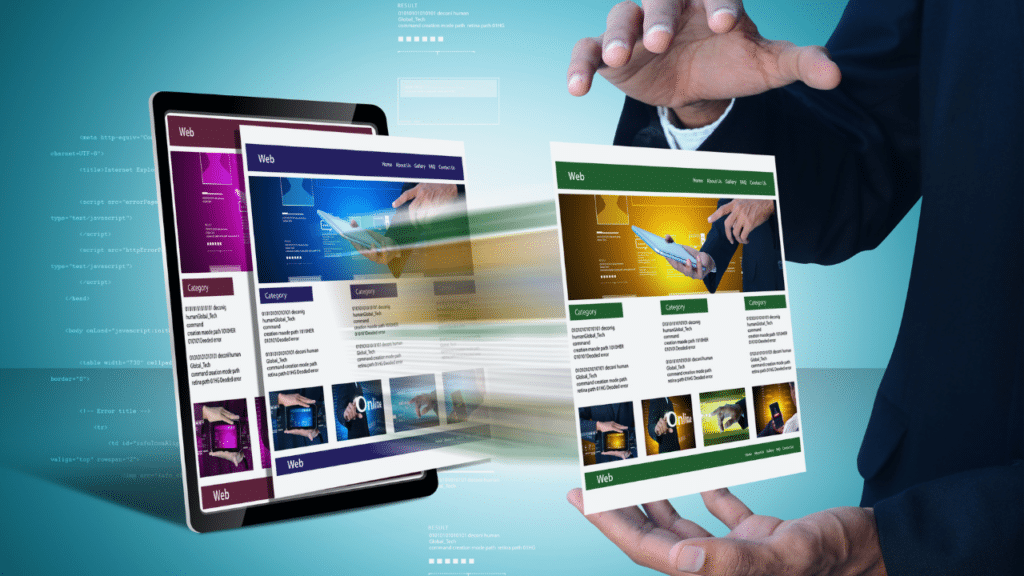You have the power to transform your website into a high-performing platform that captivates users and enhances their experience. In today’s digital landscape, the speed of your site plays a significant role in retaining visitors and converting them into loyal clients. By implementing effective website design strategies, you can significantly increase loading times and streamline navigation, ultimately fostering a more enjoyable and efficient user experience. This blog post will guide you through crucial design principles that not only improve speed but also elevate your client’s overall interaction with your site.

Key Takeaways:
- Optimize Images: Large images can significantly slow down a website. Use compression tools and choose appropriate formats to enhance loading speed.
- Minimize HTTP Requests: Reducing the number of elements on a page lowers the number of HTTP requests, leading to faster load times.
- Implement Responsive Design: A mobile-friendly design improves user experience across various devices, increasing accessibility and engagement.
Importance of Website Speed
Before you investigate into design elements, it’s necessary to understand that website speed directly influences user satisfaction and conversion rates. In today’s fast-paced digital world, you have only a few seconds to capture your audience’s attention. If your site takes too long to load, users are likely to abandon it and seek faster alternatives, leading to noticeable losses in customer engagement and potential revenue.
Impact on User Experience
Along with aesthetics, speed plays a significant role in shaping the user’s experience on your website. A fast-loading site ensures smooth navigation, allowing visitors to find the information they need quickly. When users encounter delays, they may feel frustrated, which can damage your brand’s reputation and drive them away.
Search Engine Rankings
Behind the scenes, website speed is a vital factor that search engines consider when ranking your website. Slower sites may find themselves pushed down in search engine results pages (SERPs), making it harder for potential customers to discover your offerings.
In addition to speed affecting user engagement, search engines prioritize fast-loading websites to enhance their own user experience. This means that if you improve loading times, you not only cater to your visitors but also boost your chances of achieving higher rankings on platforms like Google. A faster website signals quality and reliability to both your audience and search engine algorithms, giving you an edge in visibility and traffic.
Key Strategies for Optimizing Speed
While optimizing your website’s speed is important for enhancing user experience, implementing effective strategies can make all the difference. By focusing on both front-end and back-end optimizations, you can significantly reduce load times and create a seamless browsing experience for your visitors. Consider prioritizing the following methods to ensure your website performs at its best.
Efficient Code and Design Practices
By streamlining your code and utilizing efficient design frameworks, you can enhance your site’s performance. Minimizing HTTP requests, reducing file sizes, and eliminating unnecessary scripts will not only speed up load times but also improve overall functionality. Simplifying your layout and avoiding excessive animations can also contribute to a faster, more responsive website.
Image and Media Optimization
Behind every visually appealing website is a need for image and media optimization. Large image files and uncompressed videos can slow down your site significantly, detracting from the user experience. Adopting best practices like resizing images, using the right file formats, and compressing media before uploading can lead to notable improvements in speed.
Plus, optimizing your images and media is not just about reducing file sizes; it’s also about the right formats. Using formats like WebP for images and leveraging lazy loading for videos can enhance loading times while retaining quality. Additionally, serving responsive images tailored to different devices will ensure your website displays beautifully and performs optimally across all platforms, ultimately delighting your audience.
Leveraging Content Delivery Networks (CDNs)
All website owners should consider leveraging Content Delivery Networks (CDNs) to enhance speed and improve client experience. CDNs distribute your website content across multiple servers worldwide, dramatically reducing load times by serving your site’s assets from a location closer to your users. This not only speeds up accessibility, but also ensures a smoother online experience, allowing your visitors to interact with your content seamlessly, regardless of their geographic location.
Benefits of CDNs
At the heart of using CDNs are several key advantages, including faster load times, reduced bandwidth costs, and improved site reliability. By caching your content at various locations, CDNs help deliver data to users more quickly, minimizing latency. This ultimately enhances user retention and satisfaction, as faster websites lead to better engagement and increased conversions.
Choosing the Right CDN
By selecting the right CDN for your specific needs, you can maximize the benefits of enhanced speed and performance. Key factors to consider include the network size, geographic coverage, and pricing models offered by different CDN providers. Assess your audience’s location and the nature of your content to find a CDN that aligns with your requirements.
It’s important to compare features like scalability, security options, and customer support when evaluating CDNs. Look for providers that offer flexible plans that can grow with your traffic needs, as well as robust security measures such as DDoS protection. Check user reviews and performance statistics to gauge reliability, and consider a CDN that integrates smoothly with your existing website platform for the best experience.
Responsive Design and Mobile Optimization
Many users now access websites primarily through mobile devices, making it crucial for your site to embrace responsive design principles. By optimizing your website for various screen sizes, you improve the overall Customer Experience on Website | Improve CX. This ensures that visitors have a seamless experience, regardless of the device they use, thus enhancing client satisfaction and engagement.
Importance of Mobile Speed
Responsive design enhances user experience by ensuring that your mobile site loads quickly, which is vital for retaining visitors. A sluggish mobile site can lead to frustration, causing potential clients to abandon your page before even viewing your content.
Best Practices for Mobile Design
An effective mobile design must focus on intuitive navigation and quick loading times. Prioritize content, utilizing large, legible fonts and appropriately sized images. This approach not only enhances usability but also encourages user retention.
At the same time, consider implementing touch-friendly buttons and minimizing unnecessary elements that could clutter the mobile experience. Streamlined navigation and crucial functions should front center, enabling you to guide users efficiently through your website. Prioritizing these best practices will significantly elevate the mobile experience, ensuring that clients stay engaged and satisfied with your services.
Testing and Monitoring Website Performance
Unlike the misconception that a website’s speed is a one-time concern, ongoing testing and monitoring are crucial for maintaining optimal performance. By regularly assessing your website’s speed and functionality, you can identify and resolve issues before they impact user experience. Implementing automated tools allows you to gain insights into your website’s performance, ensuring that your visitors enjoy a seamless browsing experience while, at the same time, protecting your site’s reputation and search ranking.
Tools for Speed Testing
Any effective speed testing strategy begins with the right tools. Utilize reliable platforms such as Google PageSpeed Insights, GTmetrix, or Pingdom to analyze your website’s load times and performance metrics. These tools provide detailed reports on what aspects of your site need improvement, helping you to make data-driven decisions that enhance user experience and boost speed.
Continuous Improvement Strategies
After you have implemented initial optimizations, it’s important to adopt continuous improvement strategies to keep your website running at peak performance. Regularly revisit your speed tests and analyze user feedback to identify new areas for enhancement.
Due to the ever-changing nature of web standards and user expectations, a proactive approach toward continuous improvement ensures your website stays competitive. Keep an eye on emerging technologies and best practices, adapting your strategies as necessary. Regular updates, optimizing images, minimizing HTTP requests, and leveraging browser caching are just a few tactics that can help you maintain a fast and engaging user experience. By continually assessing and refining your website’s performance, you’ll effectively meet the evolving needs of your audience.
Enhancing Client Experience Through UX Design
For your website to truly resonate with clients, focusing on user experience (UX) design is vital. By creating an intuitive and engaging digital environment, you can significantly enhance client satisfaction and foster long-term relationships. Prioritizing UX ensures that your users find it easy to navigate your site, access information quickly, and ultimately enjoy their overall experience, which translates to increased conversion rates and repeat visits.
User-Centered Design Principles
Below are key aspects of user-centered design principles that you should incorporate into your website. Your design choices should reflect the needs, preferences, and behaviors of your target audience. This approach involves understanding your users through research and testing, allowing you to create interfaces that facilitate seamless interactions. Simple navigation, clear calls to action, and accessible information all contribute to a more satisfying user experience.
Feedback and Iteration
Among the many strategies to refine your UX design, soliciting and integrating user feedback is paramount. Engaging with your audience through surveys, usability tests, and direct comments provides invaluable insights that can inform enhancements. By allowing users to voice their opinions, you create a collaborative atmosphere that fosters trust and demonstrates your commitment to meeting their needs.
Iteration is an ongoing process that helps you fine-tune your site based on real user experiences. By continuously assessing how clients interact with your website, you can identify pain points and areas for improvement. This commitment to refining your design ensures that your website evolves with your audience’s preferences and behaviors, resulting in an ever-improving user experience that keeps clients engaged and satisfied.
To wrap up
On the whole, implementing effective website design strategies is vital for enhancing speed and improving your client experience. By optimizing images, minimizing code, and utilizing reliable hosting solutions, you can significantly reduce load times. Additionally, prioritizing mobile responsiveness and streamlined navigation will make your site more user-friendly. These approaches not only elevate user satisfaction but also encourage conversions, ultimately contributing to your business success. Embrace these strategies to create a faster, more efficient website that meets your users’ needs and expectations.
Q: What are the key elements of website design that can enhance loading speed?
A: Several elements can enhance loading speed, including optimizing images and media files by compressing them without sacrificing quality, minimizing the use of heavy scripts or plugins, and employing lazy loading techniques. Additionally, utilizing a Content Delivery Network (CDN) can help distribute the load and speed up content delivery to users based on their geographic location. Streamlining the website’s code by eliminating unnecessary CSS and JavaScript and taking advantage of browser caching can also significantly boost speed.
Q: How can website design improve the overall client experience?
A: A well-designed website can greatly improve client experience by prioritizing user-friendly navigation and accessibility. This includes creating a logical layout that allows users to find information quickly, using responsive design to ensure the site functions well across all devices, and incorporating intuitive call-to-action buttons. Additionally, providing engaging and relevant content tailored to the audience’s needs fosters a deeper connection. Incorporating feedback mechanisms like surveys or chat options can also enhance user interaction and satisfaction.
Q: What role does website performance play in SEO and online visibility?
A: Website performance is a significant factor in SEO, as search engines prioritize sites that load quickly and provide a smooth user experience. Pages that take too long to load can lead to higher bounce rates, negatively impacting user engagement metrics that search engines consider when ranking sites. Optimizing design elements such as page speed, mobile responsiveness, and overall usability can improve search engine rankings, increasing online visibility and attracting more traffic. Furthermore, implementing structured data and keeping up with SEO best practices contributes to better performance in search engine results.







